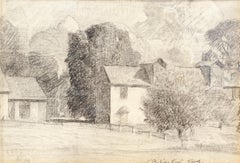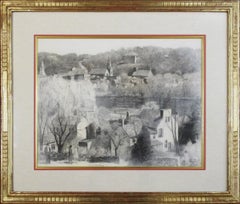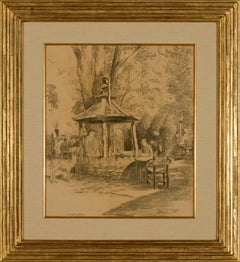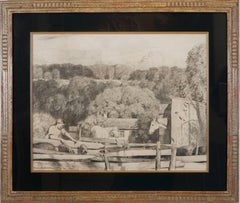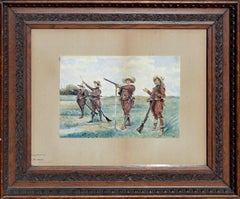American Impressionist Drawings and Watercolor Paintings
to
6
6
5
1
2
3
1
Overall Height
to
Overall Width
to
6
3
1
1
1
1
1
1
1
6
2
15
38
18
15
15
5
3
3
1
Style: American Impressionist
Artist: Daniel Garber
Daniel Garber Original Drawing, from Artist's Estate
Located in Larchmont, NY
Daniel Garber (American, 1880-1958)
Balderstons, c. Early 20th Century
Pencil on paper
7 x 9 in.
Framed: 12 x 4 x 1/2 in.
Titled and initialed lower right: Balderstons, D.G.
Proven...
Category
Early 20th Century American Impressionist Drawings and Watercolor Paintings
Materials
Paper, Pencil
"Bare Tree"
Located in Lambertville, NJ
Jim’s of Lambertville Fine Art Gallery is proud to present this piece by Daniel Garber (1880 - 1958).
One of the two most important and, so far, the most valuable of the New Hope School Painters, Daniel Garber was born on April 11, 1880, in North Manchester, Indiana. At the age of seventeen, he studied at the Art Academy of Cincinnati with Vincent Nowottny. Moving to Philadelphia in 1899, he first attended classes at the "Darby School," near Fort Washington; a summer school run by Academy instructors Anshutz and Breckenridge. Later that year, he enrolled at the Pennsylvania Academy of the Fine Arts. His instructors at the Academy included Thomas Anshutz, William Merritt Chase and Cecilia Beaux. There Garber met fellow artist Mary Franklin while she was posing as a model for the portrait class of Hugh Breckenridge. After a two year courtship, Garber married Mary Franklin on June 21, 1901.
In May 1905, Garber was awarded the William Emlen Cresson Scholarship from the Pennsylvania Academy, which enabled him to spend two years for independent studies in England, Italy and France. He painted frequently while in Europe, creating a powerful body of colorful impressionist landscapes depicting various rural villages and farms scenes; exhibiting several of these works in the Paris Salon.
Upon his return, Garber began to teach Life and Antique Drawing classes at the Philadelphia School of Design for Women in 1907. In the summer of that same year, Garber and family settled in Lumbertville, Pennsylvania, a small town just north of New Hope. Their new home would come to be known as the "Cuttalossa," named after the creek which occupied part of the land. The family would divide the year, living six months in Philadelphia at the Green Street townhouse while he taught, and the rest of the time in Lambertville. Soon Garber’s career would take off as he began to receive a multitude of prestigious awards for his masterful Pennsylvania landscapes. During the fall of 1909, he was offered a position to teach at the Pennsylvania Academy as an assistant to Thomas Anshutz. Garber became an important instructor at the Academy, where he taught for forty-one years.
Daniel Garber painted masterful landscapes depicting the Pennsylvania and New Jersey countryside surrounding New Hope. Unlike his contemporary, Edward Redfield, Garber painted with a delicate technique using a thin application of paint. His paintings are filled with color and light projecting a feeling of endless depth. Although Like Redfield, Garber painted large exhibition size canvases with the intent of winning medals, and was extremely successful doing so, he was also very adept at painting small gem like paintings. He was also a fine draftsman creating a relatively large body of works on paper, mostly in charcoal, and a rare few works in pastel. Another of Garber’s many talents was etching. He created a series of approximately fifty different scenes, most of which are run in editions of fifty or less etchings per plate.
Throughout his distinguished career, Daniel Garber was awarded some of the highest honors bestowed upon an American artist. Some of his accolades include the First Hallgarten Prize from the National Academy in 1909, the Bronze Medal at the International Exposition in Buenos Aires in 1910, the Walter Lippincott Prize from the Pennsylvania Academy and the Potter Gold Medal at the Art Institute of Chicago in 1911, the Second Clark Prize and the Silver Medal from the Corcoran Gallery of Art for “Wilderness” in 1912, the Gold Medal from the Panama-Pacific Exposition in San Francisco of 1915, the Second Altman Prize in1915, the Shaw prize in 1916, the First Altman Prize in 1917, the Edward Stotesbury Prize in1918, the Temple Gold Medal, in 1919, the First William A...
Category
Early 20th Century American Impressionist Drawings and Watercolor Paintings
Materials
Paper, Charcoal
"View of Lambertville"
Located in Lambertville, NJ
Jim’s of Lambertville Fine Art Gallery is proud to present this piece by Daniel Garber (1880 - 1958).
One of the two most important and, so far, the most valuable of the New Hope Sc...
Category
1940s American Impressionist Drawings and Watercolor Paintings
Materials
Paper, Charcoal
"Horse Cart"
Located in Lambertville, NJ
Jim’s of Lambertville Fine Art Gallery is proud to present this piece by Daniel Garber (1880 - 1958).
One of the two most important and, so far, the most valuable of the New Hope Sc...
Category
Early 20th Century American Impressionist Drawings and Watercolor Paintings
Materials
Paper, Graphite
"Lunch at the Stockton Inn"
Located in Lambertville, NJ
Jim’s of Lambertville is proud to offer this artwork.
Signed lower left. Pencil drawing.
Complemented by a hand carved and gilt frame.
Daniel Garber (1880-1958)
...
Category
20th Century American Impressionist Drawings and Watercolor Paintings
Materials
Paper, Pencil
"Pigs"
Located in Lambertville, NJ
Jim’s of Lambertville Fine Art Gallery is proud to present this piece by Daniel Garber (1880 - 1958).
One of the two most important and, so far, the most valuable of the New Hope Sc...
Category
1940s American Impressionist Drawings and Watercolor Paintings
Materials
Charcoal
Related Items
"Arquebusiers En Manoeuvre", After Marchetti
Located in Soquel, CA
Figurative landscape of four infantrymen in formation with their long arquebus guns by Adolphe Ancker (Dutch, 19th Century), after Marchetti. Signed and dated "Adolph Ancker 1888" lo...
Category
1880s American Impressionist Drawings and Watercolor Paintings
Materials
Paper, Watercolor, Pencil
Garland Studies I
Located in New York, NY
Image dimensions: 7 ¼ x 10 ½ inches
Framed dimensions: 16 ½ x 20 inches
To produce his murals, Sargent painted monumental canvases in his studios in London and Boston, adhering them...
Category
1920s American Impressionist Drawings and Watercolor Paintings
Materials
Paper, Pencil
"Train Station, " Max Kuehne, Industrial City Scene, American Impressionism
By Max Kuehne
Located in New York, NY
Max Kuehne (1880 - 1968)
Train Station, circa 1910
Watercolor on paper
8 1/4 x 10 1/4 inches
Signed lower right
Provenance:
Private Collection, Illinois
Max Kuehne was born in Halle, Germany on November 7, 1880. During his adolescence the family immigrated to America and settled in Flushing, New York. As a young man, Max was active in rowing events, bicycle racing, swimming and sailing. After experimenting with various occupations, Kuehne decided to study art, which led him to William Merritt Chase's famous school in New York; he was trained by Chase himself, then by Kenneth Hayes Miller. Chase was at the peak of his career, and his portraits were especially in demand. Kuehne would have profited from Chase's invaluable lessons in technique, as well as his inspirational personality. Miller, only four years older than Kuehne, was another of the many artists to benefit from Chase's teachings. Even though Miller still would have been under the spell of Chase upon Kuehne's arrival, he was already experimenting with an aestheticism that went beyond Chase's realism and virtuosity of the brush. Later Miller developed a style dependent upon volumetric figures that recall Italian Renaissance prototypes.
Kuehne moved from Miller to Robert Henri in 1909. Rockwell Kent, who also studied under Chase, Miller, and Henri, expressed what he felt were their respective contributions: "As Chase had taught us to use our eyes, and Henri to enlist our hearts, Miller called on us to use our heads." (Rockwell Kent, It's Me O Lord: The Autobiography of Rockwell Kent. New York: Dodd, Mead and Co., 1955, p. 83). Henri prompted Kuehne to search out the unvarnished realities of urban living; a notable portion of Henri's stylistic formula was incorporated into his work.
Having received such a thorough foundation in art, Kuehne spent a year in Europe's major art museums to study techniques of the old masters. His son Richard named Ernest Lawson as one of Max Kuehne's European traveling companions. In 1911 Kuehne moved to New York where he maintained a studio and painted everyday scenes around him, using the rather Manet-like, dark palette of Henri.
A trip to Gloucester during the following summer engendered a brighter palette. In the words of Gallatin (1924, p. 60), during that summer Kuehne "executed some of his most successful pictures, paintings full of sunlight . . . revealing the fact that he was becoming a colorist of considerable distinction." Kuehne was away in England the year of the Armory Show (1913), where he worked on powerful, painterly seascapes on the rocky shores of Cornwall. Possibly inspired by Henri - who had discovered Madrid in 1900 then took classes there in 1906, 1908 and 1912 - Kuehne visited Spain in 1914; in all, he would spend three years there, maintaining a studio in Granada. He developed his own impressionism and a greater simplicity while in Spain, under the influence of the brilliant Mediterranean light. George Bellows convinced Kuehne to spend the summer of 1919 in Rockport, Maine (near Camden). The influence of Bellows was more than casual; he would have intensified Kuehne's commitment to paint life "in the raw" around him.
After another brief trip to Spain in 1920, Kuehne went to the other Rockport (Cape Ann, Massachusetts) where he was accepted as a member of the vigorous art colony, spearheaded by Aldro T. Hibbard. Rockport's picturesque ambiance fulfilled the needs of an artist-sailor: as a writer in the Gloucester Daily Times explained, "Max Kuehne came to Rockport to paint, but he stayed to sail." The 1920s was a boom decade for Cape Ann, as it was for the rest of the nation. Kuehne's studio in Rockport was formerly occupied by Jonas Lie.
Kuehne spent the summer of 1923 in Paris, where in July, André Breton started a brawl as the curtain went up on a play by his rival Tristan Tzara; the event signified the demise of the Dada movement. Kuehne could not relate to this avant-garde art but was apparently influenced by more traditional painters — the Fauves, Nabis, and painters such as Bonnard. Gallatin perceived a looser handling and more brilliant color in the pictures Kuehne brought back to the States in the fall. In 1926, Kuehne won the First Honorable Mention at the Carnegie Institute, and he re-exhibited there, for example, in 1937 (Before the Wind). Besides painting, Kuehne did sculpture, decorative screens, and furniture work with carved and gilded molding. In addition, he designed and carved his own frames, and John Taylor Adams encouraged Kuehne to execute etchings. Through his talents in all these media he was able to survive the Depression, and during the 1940s and 1950s these activities almost eclipsed his easel painting. In later years, Kuehne's landscapes and still-lifes show the influence of Cézanne and Bonnard, and his style changed radically.
Max Kuehne died in 1968. He exhibited his work at the National Academy of Design, the Art Institute of Chicago, the Carnegie Institute in Pittsburgh, the Memorial Art Gallery of the University of Rochester, and in various New York City galleries. Kuehne's works are in the following public collections: the Detroit Institute of Arts (Marine Headland), the Whitney Museum (Diamond Hill...
Category
1910s American Impressionist Drawings and Watercolor Paintings
Materials
Paper, Watercolor
Figure Bending Over
Located in New York, NY
Image dimensions: 5 ½ x 3 ½ inches
Framed dimensions: 12 ⅛ x 10 ⅜ inches
Inscribed at lower left: JS 220
Our drawing is also referred to as Young Boy Adjusting His Sandal, and is illustrated in the catalogue for Sargent's 1928 exhibition of drawings at Grand Central Art Galleries in New York. It is an example of an early study from life executed c. 1874-8.*
Sargent drew continuously from an early age and had benefited from the emphasis on drawing at the Accademia delle Belle Arti in Florence where he entered the life class in 1870. He arrived in Paris on May 16th, 1874, with a large portfolio of drawings...
Category
1870s American Impressionist Drawings and Watercolor Paintings
Materials
Paper, Pencil
"Monhegan Island, Maine, " Edward Dufner, American Impressionism Landscape View
Located in New York, NY
Edward Dufner (1872 - 1957)
Monhegan Island, Maine
Watercolor on paper
Sight 16 x 20 inches
Signed lower right
With a long-time career as an art teacher and painter of both 'light' and 'dark', Edward Dufner was one of the first students of the Buffalo Fine Arts Academy to earn an Albright Scholarship to study painting in New York. In Buffalo, he had exchanged odd job work for drawing lessons from architect Charles Sumner. He also earned money as an illustrator of a German-language newspaper, and in 1890 took lessons from George Bridgman at the Buffalo Fine Arts Academy.
In 1893, using his scholarship, Dufner moved to Manhattan and enrolled at the Art Students League where he studied with Henry Siddons Mowbray, figure painter and muralist. He also did illustration work for Life, Harper's and Scribner's magazines.
Five years later, in 1898, Dufner went to Paris where he studied at the Academy Julian with Jean-Paul Laurens and privately with James McNeill Whistler. Verification of this relationship, which has been debated by art scholars, comes from researcher Nancy Turk who located at the Smithsonian Institution two 1927 interviews given by Dufner. Turk wrote that Dufner "talks in detail about Whistler, about how he prepared his canvasas and about numerous pieces he painted. . . A great read, the interview puts to bed" the ongoing confusion about whether or not he studied with Whistler.
During his time in France, Dufner summered in the south at Le Pouleu with artists Richard Emil Miller...
Category
Early 20th Century American Impressionist Drawings and Watercolor Paintings
Materials
Paper, Watercolor
Albert Lorey Groll, American 1866-1952 Pencil sketch.
By Albert Groll
Located in Hallowell, ME
6.5" x 8" pencil on paper. Crows in a landscape. In custom mat from Kennedy Galleries, approx 14" x 20"Born in New York City, Albert Lorey Groll became a much admired, successful western desert...
Category
Early 20th Century American Impressionist Drawings and Watercolor Paintings
Materials
Pencil
"River Landscape" Julian Alden Weir, American Impressionist, Connecticut Scene
Located in New York, NY
Julian Alden Weir
River Landscape
Signed lower left
Watercolor on paper
9 x 11 1/2 inches
Provenance:
Kraushaar Galleries, New York
Sotheby's Parke Bernet, New York, 1965, Lot 27
E....
Category
Late 19th Century American Impressionist Drawings and Watercolor Paintings
Materials
Watercolor, Paper
Landscape View With Cows Drinking Water by American Artist Hugo Anton Fisher
Located in Stockholm, SE
American artist Hugo Anton Fisher was primarily known for painting landscapes in watercolor. He was born into a family of artists in Kladno, Bohemia....
Category
Late 19th Century American Impressionist Drawings and Watercolor Paintings
Materials
Paper, Watercolor
Free Shipping
H 11.42 in W 17.52 in
This Ain't Sotheby's This is Texas, Rosemary Mahoney, Cattle Auctions,
Located in Houston, TX
"People, the human figure, fascinate me. Regardless of age or social status, I take particular interest in grasping the one moment that belongs solely to an individual." - Rosemary Mahoney...
Category
1990s American Impressionist Drawings and Watercolor Paintings
Materials
Charcoal, Carbon Pencil
State Capitol at Night, Sacramento, California
Located in San Francisco, CA
This artwork titled "State Capitol at night, Sacramento, California" c.1960 is a watercolor on paper by noted California artist William Jack Laycox, 1921-1984. It is signed at he low...
Category
Mid-20th Century American Impressionist Drawings and Watercolor Paintings
Materials
Watercolor
H 30.5 in W 39.75 in D 1.1 in
"Old Adobe Village, New Mexico" Alice Schille, Taos Pueblo, Female Impressionist
By Alice Schille
Located in New York, NY
Alice Schille
Old Adobe Village, New Mexico
Signed lower right
Watercolor on paper
5 x 6 inches
Provenance:
Estate of the artist
Keny and Johnson Gallery, Columbus, Ohio
Santa Fe East Galleries, Santa Fe, New Mexico
Private Collection, California
A painter in watercolor and oil, Alice Schille was a prolific artist using modernist styles of Post-Impressionism, Pointillism and Fauvism. Her subjects included portraits of women and children, landscapes with and without figures, a series of scenes of New York City. New Mexico, and Gloucester, Massachusetts. Her paintings also reflected her widespread international travels in Europe, North Africa, Russia, the Middle East, Mexico, and Guatemala.
Although personally very shy, Schille possessed unusual courage and strength of will, which was reflected in both her independent lifestyle and in her work, as she continually worked to master new modes of painting throughout her career. A German critic once referred to Schille as "this daredevil disciple of art who is interested in anything and afraid of nothing."
Alice Schille was born in Columbus, Ohio to a family supported by her father's success in manufacturing. She was raised in Columbus, and by the time she was age six, she determined to be an artist. She graduated at the top of her class from Central High School in 1887, studied from 1891 to 1893 at the Columbus Art School, and returned there as a teacher from 1902 to 1948.
Going to New York City as a young woman, she enrolled in the Art Students League from 1897 to 1899 and then the New York School of Art with William Merritt Chase and Kenyon Cox. (Some years later, she attended Chase's Shinnecock Summer School on Long Island). From 1903 to 1904, Alice Schille was in Paris at the Academie Colarosi, and also studied privately with Raphael Collin, Rene Prinet, Gustave Courtois and Chase, who was then in Europe.
In 1904, five of her paintings were accepted for exhibition at Societe Nationale des Beaux Arts, and from that time on her work was included regularly in important American annual exhibitions including the Pennsylvania Academy, the Corcoran Gallery, American Watercolor Society, Boston Art Club, and the 1987 inaugural exhibition of the National Museum of Women in the Arts in Washington DC.
Between 1905 and 1914, Alice Schille painted in Europe, and during the summers of 1916 to 1918, worked in New York and Gloucester. In 1919, she was in New Mexico. On this trip, her first to the Southwest, she spent a summer in Taos and Santa Fe and painted scenes including the Taos Pueblo, Canyon Road and local Hispanic and Indian figures. Reportedly the Ranchos de Taos Church was one of her favorite subjects. Many of these New Mexico paintings were hung at annual exhibitions of the Philadelphia Water Color Club.
Between 1920 and 1940, she traveled frequently in the summers, returning to New Mexico and going to Central America and Africa. In 1922, she began her first series of North-African watercolors...
Category
1920s American Impressionist Drawings and Watercolor Paintings
Materials
Paper, Watercolor
Mid Century Country Meadow and Hills Landscape
By Rene Weaver
Located in Soquel, CA
Mid Century Country Meadow and Hills Landscape
Mid Century California Meadow and Hills landscape, watercolor of a pathway through rolling hills by California artist Rene Weaver (Amer...
Category
1950s American Impressionist Drawings and Watercolor Paintings
Materials
Paper, Watercolor
American Impressionist drawings and watercolor paintings for sale on 1stDibs.
Find a wide variety of authentic American Impressionist drawings and watercolor paintings available for sale on 1stDibs. Works in this style were very popular during the 21st Century and Contemporary, but contemporary artists have continued to produce works inspired by this movement. If you’re looking to add drawings and watercolor paintings created in this style to introduce contrast in an otherwise neutral space in your home, the works available on 1stDibs include elements of blue, purple, orange, green and other colors. Many Pop art paintings were created by popular artists on 1stDibs, including Les Anderson, Laurence Sisson, Arnold A. Grossman, and Joseph Yeager. Frequently made by artists working with Paint, and Watercolor and other materials, all of these pieces for sale are unique and have attracted attention over the years. Not every interior allows for large American Impressionist drawings and watercolor paintings, so small editions measuring 2 inches across are also available. Prices for drawings and watercolor paintings made by famous or emerging artists can differ depending on medium, time period and other attributes. On 1stDibs, the price for these items starts at $195 and tops out at $95,000, while the average work sells for $850.
Recently Viewed
View AllMore Ways To Browse
Japanese Watercolor Panel
Palm Tree Watercolor
Bath Poster
Dior Top Mens
Gay Vintage Drawings
Thousand Of Nights
Basquiat Green
Russian Interior Watercolors
New Zealand Watercolor
Santa Fe Chairs
Bennett Tom
Antique Watercolor Boxes
Antique Watercolor Box
Antique Watercolour Box Boxes
Antique Watercolor Box Boxes
Antique Watercolour Box
Antique Watercolour Boxes
Joan Miro Watercolor
